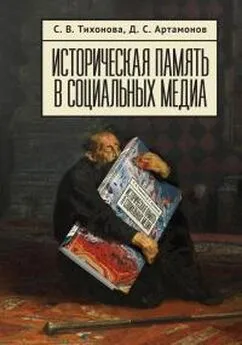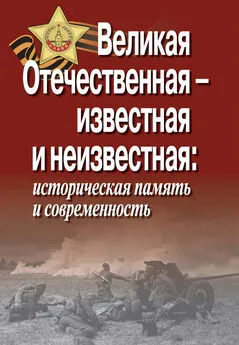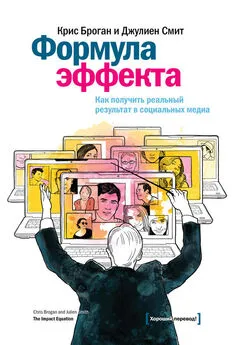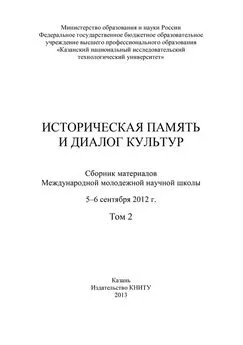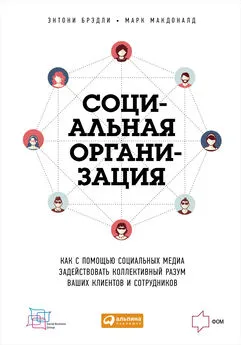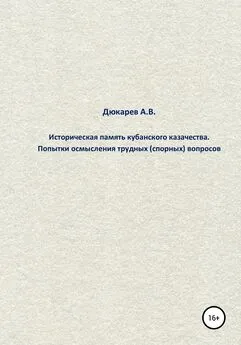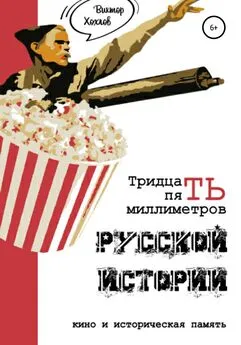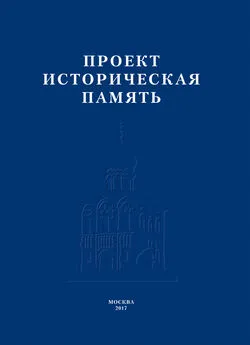Софья Тихонова - Историческая память в социальных медиа
- Название:Историческая память в социальных медиа
- Автор:
- Жанр:
- Издательство:ООО «ЛитРес», www.litres.ru
- Год:2021
- ISBN:нет данных
- Рейтинг:
- Избранное:Добавить в избранное
-
Отзывы:
-
Ваша оценка:
Софья Тихонова - Историческая память в социальных медиа краткое содержание
Историческая память в социальных медиа - читать онлайн бесплатно ознакомительный отрывок
Интервал:
Закладка:
Франция-память / Пьер Нора и др.; пер. с фр. Д. Хапаевой. СПб: Изд-во Санкт-Петербургского ун-та, 1999. 325 с.
Фурс В.Н. Глобализация жизненного мира в свете социальной теории (к постановке проблемы) // Общественные науки и современность. 2000. № 6. С. 130.
Хаттон П.Х. История как искусство памяти. СПб.: Изд-во Владимир Даль, 2003. 328 с.
Хитрова Т.В. Медиатизация «исторической памяти» как средство моделирования социальных процессов //Журналістыка-2016: стан, праблемы і перспектывы: матэрыялы 18-й Міжнароднай навукова-практычнай канферэнцыі, прысвечанай 95-годдзю БДУ (10–11 лістапада 2016 г., Мінск). Вып. 18. Мінск: БДУ, 2016. С. 205–208.
Хут Л.Р., Чеучева А.К. Цифровая история в эпоху антропоцена // Вестник Адыгейского государственного университета. Серия 1: Регионоведение: философия, история, социология, юриспруденция, политология, культурология. 2019. № 4 (249). С. 99–109.
Чесноков В.И. Правительство и развитие структуры исторических кафедр и наук в университетах России (по университетским уставам 1804–1869 годов) // Российские университеты в XIX-начале XX века: Сб. науч. ст. Воронеж: Изд-во Воронеж. ун-та, 1993. 149 с.
Чубарь П.И. Визуальный и медиальный повороты сквозь призму осмысления современной культуры // Молодежный вестник Санкт-петербургского государственного института культуры. 2016. № 1 (5). С. 5–7.
Шапинская Е.Н. История в цифровом формате: будущее нашего прошлого // Культура культуры. 2020. № 1. С. 6.
Шестак ЛА. Политическая лингвистика: фрейм события и фейк-ньюс // Cross – cultural studies: education and science. 2018. № 3. С. 194–199.
Шестакова Э.Г. Медиатекст и проблема социального забвения // Вестник Новосибирского государственного университета. Серия: История, Филология. 2013. Т. 12. № 10. С. 30–38.
Шилина М.Г. Текстогенные трансформации инфосферы. Методологический эскиз становления Интернета. М.: РИЦ «Северо-Восток», НИУ ВШЭ, 2012. 734 с.
Шиповалова Л.В. Современная историческая эпистемология. Аналитический обзор направления исследований // Цифровой ученый: лаборатория философа. 2018. Т. 1. № 4. С. 153–167.
Шмелева Т.В. Медиатизация как феномен современной культуры и объект исследования // Вестник Новгородского государственного университета. 2015. № 90. С. 145–148.
Шнедельбах Г. Университет Гумбольдта // Логос. 2002. № 5–6. С. 65–78.
Шомова СА. Выборы президента РФ – 2018 в зеркале мемов: новые реалии политической коммуникативистики // Полис. Политические исследования. 2019. № 3. 157–173. https://doi.org/10.17976/jpps/2019.03.10
Шомова С.А. Политический интернет-мем: сущность, специфика, разновидности // Бизнес. Общество. Власть. 2015. № 22. С. 2825441.
Шуталева А.В., Путилова Е.А. Интернет-мем как способ воспроизводства социальной памяти // Исторические, философские, политические и юридические науки, культурология и искусствоведение. вопросы теории и практики. 2017. № 12-3 (86). С. 219–221.
Amoretti M.C. On the social dimension of beliefs and concepts // Epistemology of Ordinary Knowledge. Edited by Mariano L. Bianca and Paolo Piccari. Cambridge Scholars Publishing, 2015, рр. 195–210.
Bell D.SA. Mythscapes: memory, mythology, and national identity // British Journal of Sociology. 2003. Vol. 54, No. 1. P. 63–81.
Bellinger M. «Bae Caught Me Tweetin’: On the Representational Stance of the Selfie» // International Journal of Communication. 2015. № 9 P. 1806–1817.
Bianca M.L. The Epistemological structure of ordinary knowledge // Epistemology of Ordinary Knowledge. Edited by Mariano L. Bianca and Paolo Piccari. Cambridge Scholars Publishing, 2015, рр. 3-38.
Blackmore S. The Meme Machine. Oxford: Oxford University Press. 1999. 264 p.
Bogost J. How to do something with video games Minneapolis, MN: University of Minnesota press, 2011. 180 p.
Bogost J. Persuasive Games: The Expressive Power of Videogames. Cambridge, Massachusetts; London, England: The MIT Press, 2007. 464 p.
Bosman F.G. The Sacred and the Digital. Critical Depictions of Religions in Digital Games. // Religions. 2019. № 10. P. 130. doi.org/10.3390/ rel10020130
Bosman F.G, Wieringen A.L.H.M. I Have Faith in Thee, Lord: Criticism of Religion and Child Abuse in the Video Game the Binding of Isaac // Religions. 2018. № 9. P. 133. doi.org/10.3390/rel9040133
Boyd C.P. The Politics of History and Memory in Democratic Spain // The Annals of the American Academy of Political and Social Science. 2008. N 617. P. 133–148.
Brodie R. Virus of the Mind: The New Science of the Meme. Seattle, WA: Integral Press. 1996. 260 p.
Burgess J., Green J. YouTube: Online Video and Participatory Culture (Second Edition). Medford, MA: Polity Press, 2018. 191 p.
Burns A. «Selfie-correction» // The New Inquiry. 2014. № 4 August. URL: http://thenewinquiry.com/essays/selfie-correction/(accessed 23.04.2021)
Catechumen. 2000 // URL: https://www.old-games.ru/game/8083.html(дата обращения: 02.04.2020)
Chapman A. Privileging Form Over Content: Analyzing Historical Video Games // Journal of Digital Humanities. 2012. Vol. 1. No. 2. Spring. P. 42–46.
Davison P. The Language of Internet Memes. – The Social Media Reader. Ed. by M. Mandiberg. New York, London: New York University Press. 2009. Р. 120–134.
Dennett D. Consciousness Explained. Boston: Little, Brown a. co., Cop. 1991. 511 p.
Digital 2020: 3,8 миллиарда человек используют социальные сети / Wearesocial & Hootsuite, 2020. URL: https://wearesocial.com/blog/2020/01/digital-2020-3-8-billion-people-use-social-media.
Dosi G, Labini M. The relationships between science, technologies and their industrial exploitation: an illustration through the myths and realities of the so-called «European paradox» // Research policy. Amsterdam, 2006, vol. 35, № 10, pp. 1450–1464.
Eckel J., Ruchatz J., Wirth S. The Selfie as Image (and) Practice: Approaching Digital Self-Photography // Eckel J., Ruchatz J., Wirth S. (eds.) Exploring the Selfie: Historical, Theoretical, and Analytical Approaches to Digital Self-Photography. Marburg: Palgrave Macmillan, 2018. Pp. 1-24.
Epistemology of ordinary knowledge. edited by Mariano L. Bianca and Paolo Piccari. Cambridge Scholars Publishing, 2015. 321.
Evaluating information: The cornerstone of civil online reasoning. Executive summary Stanford history education group. November 22. 2016. 29 p. URL: https://stacks.stanford.edu/file/druid: fv751yt5934/SHEG%20Evaluating%20lnformation%20Online.pdL(дата обращения 28. 03. 2021).
Floridi L. Mature Information Societies – a Matter of Expectations // Philosophy & Technology, 2016, Volume 29, Issue 1, pp. 1–4.
FM-2030. Up-Wingers. N.Y.: The John Day Company, 1973. 279 p
Frandsen F., Johansen W . Organizational crisis communication. Los Angeles, CA: SAGE, 2016. 280 p.
Freudenthal G., McLaughlin P. (eds.) The Social and Economic Roots of the Scientific Revolution: Texts by Boris Hessen and Henryk Grossmann. Dordrecht: Springer, 2009 273 pp.
Frosh P. The Gestural Image: The Selfie, Photography Theory, and Kinesthetic Sociability // International Journal of Communication. 2015. № 9. Рр. 1607–1628.
Fuller S. Customized science as a reflection of «protscience» // Эпистемология и философия науки. М., 2015. Т. 46. № 4. С. 52–69.
Grove T. Hinshaw D. Russia and Poland Feud Over Putin Remarks on World War II // The Wall Street Journal, 11 января 2020 года. URL: https://www.wsj.com/articles/russia-and-poland-feud-over-putin-remarks-on-world-war-ii-11578756818(дата обращения: 17.03.2021).
Gunthert A. The Consecration of the Selfie: A Cultural History // Eckel J., Ruchatz J., Wirth S. Exploring the Selfie: Historical, Theoretical, and Analytical Approaches to Digital Self-Photography. Marburg: Palgrave Macmillan. 2018. P. 27–48.
Heisler M.O. The political currency of the past: History, memory, and identity // The Annals of the American Academy of Political and Social Science. 2008. Vol. 617, N 1. P. 14–24.
HeyenN.B. Quantified Self as Personal (Citizen) Science // URL: http:// blogs.harvard.edu/billofhealth/2017/05/11/quantified-self-as-per-sonal-citizen-science/ (дата обращения: 10.04.2021).
Hofstadter D.R. Metamagical Themas. Questing for the Essence of Mind and Pattern. New York: Basic Books. 1986. 853 p.
Howe J . Crowdsourcing. Why the Power of the Crowd Is Driving the Future of Business. N.Y., 2008. 280 p.
Hunt E. What is fake news? How to spot it and what you can do to stop it // https://www.theguardian.com/media/2016/dec/18/what-is-fake-news-pizzagate. (дата обращения 2 февраля 2021).
Johann M, Bhlow L. One Does Not Simply Create a Meme: Conditions for the Diffusion of Internet Memes // International Journal of Communication. 2019. 13. P. 1720–1742.
Laird S. Behold the First ‘Selfie’ Hashtag in Instagram History. // Mashable. 2013. № 19 November. URL: http://mashable.com/2013/11/19/first-selfie-hashtag-instagram/ (accessed on 15.02.2021).
Ledford H . Garage biotech: Life hackers // Nature. 2010. № 467. P. 650–652.
McClelland J S. The Crowd and the Mob: from Plato to Canetti. L., 1989. 343 p.
Merton R. The Thomas Theorem and The Matthew Effect // Social Forces. 1995. Vol. 74. Iss. 2. P. 379–424.
Читать дальшеИнтервал:
Закладка:
